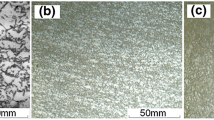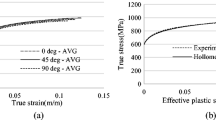Abstract
With the rising interest in lightweight construction, the usage of high and ultra-high strength steels has increased remarkably during the last years. Unfortunately, these steel grades show more springback than mild steels do, which leads in consequence to lower dimensional accuracy. To improve the bended part’s geometry considerable trial-and-error work is necessary since the influence of different bending-parameters (e.g. the bending radius, sheet thickness, yield strength, Young’s modulus, the material’s strain hardening coefficient, …) on the amount of springback is still unknown. The aim of the paper at hand is therefore the investigation of springback for different parameter combinations. Furthermore, an online calibration system for occurring springback during roll forming is presented to compensate springback independent of material or process parameters.









Similar content being viewed by others
References
Brochure NN (2008) ScaLight—scalable autobody lightweight concept. Salzgitter AG/Wilhelm Karmann GmbH, Salzgitter/Osnabrück. http://www.scalight.de/deutsch/public.html, Stand 10 June 2008
Brochure NN (2008) New steel body—Leichtbau mit Stahl. Für Automobile mit Zukunft, ThyssenKrupp Stahl AG, Duisburg. http://www.thyssenkrupp-steel.com/auto/de/publikationen/index.jsp?catcode=tkscsauto.pub.auto_informationen, Stand 10 June 2008
DIN 8586 (2003) Fertigungsverfahren Biegeumformen—Einordnung, Unterteilung, Begriffe, Beuth Verlag, Berlin
Halmos GT (2006) Roll forming handbook, 1st edn. CRC Press, New York
Schuler GmbH (1996) Handbuch der Umformtechnik, Neuauflage 1996. Springer, Berlin
Brochure NN (2008) Neue Technologie für rollformintensive Fahrzeugstrukturen aus Stahl und Aluminium. Dreistern GmbH & Co. KG, Schopfheim. http://www.dreistern.com/de/casestudy/1552/1552.htm, Stand 10 June 2008
Schiefenbusch J (1983) Untersuchungen zur Verbesserung des Umformverhaltens von Blechen beim Biegen. Dissertation, Universität Dortmund
Wen B (2007) Roll forming high-strength materials. TPJ Tube Pipe J April/May:22–27
Brochure NN (2008) Mikrolegierte Stähle PAS und MHZ. ThyssenKrupp Stahl AG, Duisburg. http://www.thyssenkrupp-steel.com/auto/de/publikationen/index.jsp?catcode=tkscsauto.pub.produktinformationen, Stand 10 June 2008
Brochure NN (2008) Bandstahl. C.D. Wälzholz GmbH & Co. KG, Hagen. http://www.cdw.de/Info_Service/Download%20Broschueren/0_360.html, Stand 10 June 2008
Sachs G (1951) Principles and methods of sheet-metal fabricating. Reinhold Publishing Corporation, New York
Dannenmann E (1969) Die Abbildegenauigkeit beim Biegen im 90°-V-Gesenk und ihre Beeinflussung durch Nachdrücken im Gesenk, IFU-Bericht Nr.8, TH Stuttgart
Bogojawlenskij K, Neubauer A, Ris V (1979) Technologie der Fertigung von Leichtbauprofilen, 1. Auflage, VEB Deutscher Verlag für Grundstoffindustrie, Leipzig
Popow EA (1968) Grundlagen der Theorie der Blechverarbeitung, 1 Auflage. Verlag Maschinenbau, Moskau
Geleji A (1960) Bildsame Formgebung der Metalle in Rechnung und Versuch, 1 Auflage. Akademie-Verlag, Berlin
Biswas AK (1967) Ein Beitrag zur Biegung von Blechen zu Rohren und Profilen. Dissertation, Universität Saarbrücken
Siebel E, Panknin W (1956) Biegefließkurven von Blechen. Industrie-Anzeiger Essen 25(3):23–25
Schwark HF (1952) Rückfederung am bildsam gebogenen Blech. Dissertation, Universität Hannover
Oehler G (1963) Biegen, 1 Auflage. Carl Hanser Verlag, München
Tschätsch H (2005) Praxis der Umformtechnik, 8 Auflage. Vieweg Verlag, Wiesbaden
Eichhorn A (1974) Ein Beitrag zu Untersuchung technologisch bedingter Formabweichungen am Werkstück beim Profilieren von Metallbändern. Dissertation, TH Magdeburg
Kalpakjian S, Schmid S (2003) Manufacturing Processes for Engineering Materials, 4th edn. Pearson Education International, Upper Saddle River
Ludwik P (1903) Technologische Studie über Blechbiegung. Technische Blätter 35:133–159 Wien
Busche CH (2007) Bestimmung und Beschreibung des Elastizitätsmoduls von Blechwerkstoffen nach dem Umformen. Dissertation, RWTH Aachen
Mynors DJ et al (2006) Controlling the cold roll forming design process. Ann CIRP 55(1):271–274
Groche P, Henkelmann M (2007) Erhöhung der Maßhaltigkeit beim Profilieren. WT-Online 10:792–797
Abele E et al (2003) Increasing the process safety with on-line process monitoring and off-line chatter prediction. Ann Ger Acad Soc Prod Eng WGP X/2:101–104
Brochure NN (2008) COPRA® ProfileCheck, data M Engineering GmbH, Valley/Oberlaindern. http://www.roll-design.com/de/COPRA-Profilchecker.htm, Stand 10 June 2008
Lunze J (2004) Regelungstechnik 1—Systemtheoretische Grundlagen Analyse und Entwurf einschleifiger Regelungen, 4 Auflage. Springer, Berlin
DIN EN 10162 (2003) Technische Lieferbedingungen Grenzabmaße und Formtoleranzen. Beuth Verlag, Berlin
Acknowledgments
The investigations presented in this paper were carried out within the research project “Intelligente Werkzeugsysteme zur Erhöhung der Profilgenauigkeit bei höher- und höchstfesten Stählen” sponsored by: Forschungsvereinigung der Arbeitsgemeinschaft der Eisen und Metallverarbeitenden Industrie e.V. (AVIF) and European Cold Rolled Section Association (ECRA). At the same time the authors would like to thank the following companies for their continuous and profound support during the project: C.D. Wälzholz GmbH, LINDE + WIEMANN GmbH KG, PROFILMETALL GmbH, Tillmann Profil GmbH, Westfalia Profiltechnik GmbH & Co. KG and data M Engineering GmbH
Author information
Authors and Affiliations
Corresponding author
Rights and permissions
About this article
Cite this article
Groche, P., Beiter, P. & Henkelmann, M. Prediction and inline compensation of springback in roll forming of high and ultra-high strength steels. Prod. Eng. Res. Devel. 2, 401–407 (2008). https://doi.org/10.1007/s11740-008-0131-3
Received:
Accepted:
Published:
Issue Date:
DOI: https://doi.org/10.1007/s11740-008-0131-3




